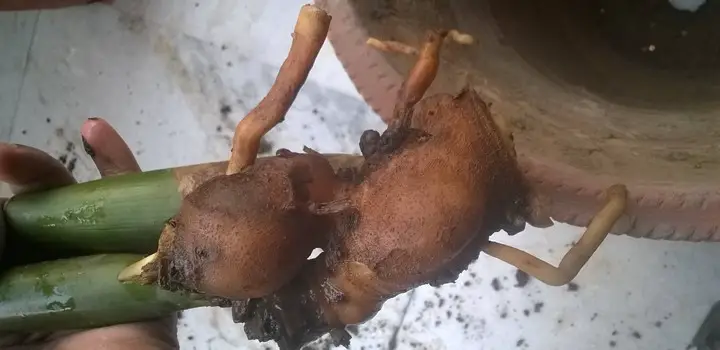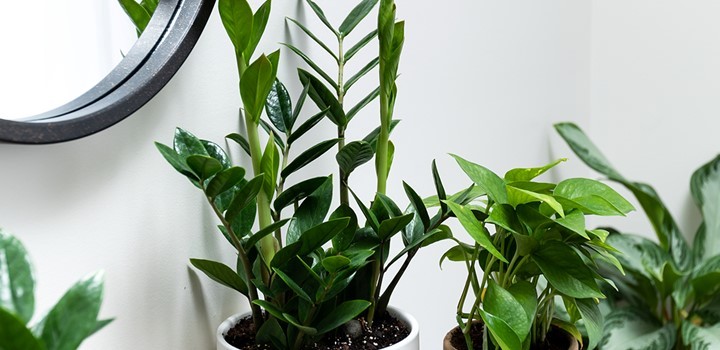ZZ Plants are a terrific choice for a houseplant because they can thrive in any environment. They need very little care until their worst enemy root rot arrives.
Because root rot is an underground problem of the ZZ plant, sometimes it gets unnoticed and ends up killing the ZZ plant. But if you can identify the problem by seeing the symptoms, you should start treating them immediately. Don’t forget that the earlier you can detect the root rot the better the chance to save your ZZ plants.
Yet, root rot isn’t easy to get rid of. You have to know exactly what to do to treat your favorite houseplant. But the good news is you don’t have to worry a single thing about it. Because this article covers pretty much everything including the symptoms and the step-by-step guide process to treat them without any hassle.
So, let’s get started-
What Is Root Rot?
Root rot is a fungal problem that is mostly caused by overwatering. Sometimes the fungi responsible for root rot stay dormant in the soil for a very long time.
Whenever the fungi get favorable conditions they damage the root system of plants. It disrupts the roots and as a result, the roots start rotting and the plant eventually dies. So whenever root rot is in the question your ZZ plant needs your urgent attention.
What Does A ZZ Plant Root Rot Look Like?

There are a few symptoms you can check to ensure your ZZ plant is suffering from root rot. Knowing the signs is very important because if you can navigate the reasons properly then you can start with the right treatment.
Leaves and Stems Become Droopy
Root rot will make the leaf and stems look drooping. Because in this case, the roots are not able to provide sufficient water and nutrients to the ZZ plants. Moreover, the stems will start getting soft.
Leaves Will Turn Yellow and Start Wilting
Since rotten roots don’t supply enough water, the leaves will turn yellow and start wilting for lack of moisture.
Roots Become Grey or Brown and Look Mushy
The injured roots become slimy and mushy with a greyish or brownish appearance.
The Soil and the Root Smells
Root rot always comes with a bad smell. This is a clear sign of root rot because you will easily be able to identify the problem by the smell.
Presence of Mold on the Plant Base
Sometimes overwatered ZZ plants suffering from root rot will grow mold around the base of the stem.
How To Tell If The ZZ Plant Has Root Rot?
You can be convinced about the root rot from seeing the above soil symptoms like yellowing or wilting of leaves. But this is not enough. You have to take the ZZ plant out of the pot very carefully and examine the roots to be completely sure.
After that wash the roots under running water very gently and remove the soils from the roots. If the roots are rotten they will be slimy and mushy with a fuzzy grey appearance.
One more thing to check is the bulbs of the ZZ plant. The bulb exposed to root rot will be mushy and brown just like the roots.
What Causes Root Rot In The ZZ Plants?
Some very common issues can easily cause root rot to your ZZ plant. If you know what causes this you can easily save your ZZ plants from root rot.
Overwatering
This is the most common reason for root rot. You see, the ZZ plants don’t need much watering. If you water them more than they need, root rot will be killing your plant silently.
Improper Soil
If your ZZ plants are in soil that’s wrong for them they will easily be susceptible to root rot. A clayey soil will hold the water in the pot and create an overwatered situation. This means if you have the wrong kind of soil your ZZ plants can suffer from root rot even if you water them the right amount.
Improper Drainage
ZZ plants are mostly grown in pots as a houseplant. You can be growing them in the right soil, watering the right amount but still running a risk of root rot. Wonder why? Because there might not be enough drainage holes in the pot to let the water drain quickly.
Wrong Kind of Pot
The pot size is very crucial to avoid root rot. If they are too big then they’ll hold too much water. And if they are too small then the roots will not have enough space to grow and the soil will pressurize the roots. In both these cases, root rot is inevitable.
Fungal Infections
Some pathogens like Phytophthora, Pythium, etc cause root rot in ZZ plants. They stay dormant in the soil and when the soil is damp they get active and start affecting the roots. In this case, the infection spreads very quickly to other plants too.
How To Treat A ZZ Plant From Root Rot?
To treat ZZ plant root rot you have to be very quick. Because it spreads to other plants and kills the plants very fast. Moreover, you need to keep the roots safe from pathogens and prevent any kind of water logging condition. Don’t worry, the process is very easy to follow.
Here is the whole step-by-step guide to fix the rotting ZZ plant:
Step-1: First, you have to pull the plant out of the soil and wash it thoroughly to remove all the soil. Then examine the rotten portion carefully. The rotten part will be slimy and smelly.
Step-2: Now, carefully cut the rotten portions but make sure you disinfect the cutting tools every time to avoid any further spread. Be very careful while disposing of these rotten parts because they can easily infect other plants if they get in contact with them.
Step-3: After that, treat the rest of the roots with a good fungicide following the label instructions (Our Pick: Bonide Copper Fungicide). It is very important to pick the right fungicide otherwise it will not be effective. After treating the roots with the fungicide you need to re-pot them in fresh soil. But don’t forget to clean the pot thoroughly because the pathogen can still be present there.
Step-4: To improve the soil add peat moss or sand to your potting mixture. This will increase the drainage capacity of the soil. You can also buy potting soil mix specially made for house plants and succulents(our pick: Miracle-Gro Indoor Potting Mix). You can also test the drainage by pouring some water on the potting soil before planting and see how long it takes to drain the water through the holes.
Step-5: After planting them in the new soil, water them immediately to reduce the transplant shock of your ZZ plant. And place them in partial shade. Gradually introduce them to direct sunlight.
Step-6: After replanting you can cut the leaves that have turned yellow. This will also reduce the stress of the newly planted ZZ plants. After a while, new green leaves will be produced once the plant has recovered. Also, cut back any stems that have turned soft.
Step-7: Avoid fertilizing the plant just after replanting. Because the roots become very delicate right after the pruning. If you fertilize them immediately the roots will get burned. Let them some time to settle in and then fertilize them lightly once new growth starts in the ZZ plant.
Note: ZZ plants can irritate your skin because their sap contains calcium oxalate that is slightly toxic. It’s better to work with them wearing gloves. And always avoid touching your face and eyes while working with them. In case of contact with eyes or skin wash with plenty of water immediately and contact with a doctor.
DIY Fungicide Solutions
Some homemade DIY Fungicides are amazing for ZZ plants’ root rot treatment. And the best thing about them is they are mostly free from any side effects. Here are 3 potential root rot fungicide recipes for you to try:
#Recipe 1:- Vinegar Spray Recipe
Ingredients:
- 2 teaspoons of apple cider vinegar
- a liter of water
- Few drops of liquid dish soap
Steps:
- Mix the ingredients very well and pour them on the soil of the ZZ plant as much as required
- Repeat twice a week
# Recipe 2:- Baking Soda Spray Recipe
Ingredients:
- Baking Soda 1 teaspoon
- Few drops of liquid soap
- 1 liter of water
Steps:
- Mix the ingredients well
- Pour a reasonable amount on the base of the ZZ plant
- Repeat 2 or 3 times a week until the root rot problem is solved
#Recipe 3:- Cinnamon Spray Recipe
Ingredients:
- 1 tablespoon of cinnamon powder
- 1 liter of water
Steps:
- Mix them together and Let this solution rest overnight
- Then strain with a fine cloth and pour it into a bottle
- Store this to use multiple times
- Pour some amount on the base according to the ZZ plant size.
- Try repeating it twice a week.
Note: Do not go overboard with the Homemade fungicide doses. Too much application will injure the roots. Apply according to the size of your ZZ plant.
How To Protect A ZZ Plant From Root Rot?
To prevent root rot in the future you must always water them very lightly once every week in the summer. And water them once every three weeks in winter. Remember that underwatering is better than overwatering your ZZ plants.
But this is not always applicable. If the weather is too hot then you might need to water them twice a week. It’s best to check with a moisture meter to see if the soil needs water (Our pick: Atree Soil Soil Tester Kits with Moisture, Light, and PH Test for Garden).
Never use the old soil when replanting the ZZ plants. Root rot pathogens are soil-borne so the old soil will bring back the disease even after treatment. Always use clean and new potting soil
Always keep the soil in check and notice the drainage rate after watering. As the plant grows, shift them into bigger pots with enough drainage holes.
Conclusion
Root rot is a very irritating disease of the ZZ plant. It often harbors in the soil and injures the roots beyond repair. But if you notice the symptoms at an early stage you can bring them back to their health.
I have tried my level best to include every necessary information about root rot along with its treatment and prevention measures. I hope you have found this article helpful and easy to understand while treating your ZZ plants.
Don’t forget to share this with other house plant enthusiasts. I would love to hear back from you about your experience with ZZ plant root rot.
If you’ve made it to the end of this article, I want to offer you a bit of encouragement! Saving ZZs from root rot can be a bit scary, but in my opinion, it’s always worth the try. Even if your current plant is beyond saving, you can always remove the healthy parts and propagate. Good luck to you my friend! May the odds be ever in your favor!
